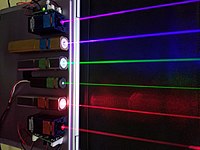
Photo from wikipedia
Ground-penetrating radar (GPR) and the seismic surface wave method are two geophysical techniques commonly used in near-surface surveys up to a depth of tens of meters. GPR can be utilized… Click to show full abstract
Ground-penetrating radar (GPR) and the seismic surface wave method are two geophysical techniques commonly used in near-surface surveys up to a depth of tens of meters. GPR can be utilized to clearly distinguish lithologic interfaces, while the seismic surface wave method (hereby referred to as the Rayleigh wave) is employed for its high sensitivity to the shear ( S ) wave velocity. However, the propagation velocity of the electromagnetic (EM) wave which is both initiated and tracked by GPR is difficult to determine within the stratum. Unfortunately, this can affect the time–depth conversion and interpretation of the radargram. Moreover, both the horizontal resolution and the detectability of the properties of the shallow stratum are limited by the seismic geometry of the Rayleigh wave data. It is important to note that the non-uniqueness of geophysical inversion problem also generates additional biases. To overcome the problems mentioned above, we put forward an interactive integrated geophysical system that utilizes the thickness as a bridge to connect GPR and the Rayleigh wave data in the data processing and inversion. In this study, we employed the velocity of a radagram and the Rayleigh wave dispersion curve inversion based on a genetic algorithm to reconstruct the near-surface distribution. Then, we set the thickness derived from the GPR data as limit of the Rayleigh wave dispersion curve inversion. Hence, we applied the constrained inversion result to determine the most accurate EM wave velocity. As expected, both the constrained inversion of the Rayleigh wave dispersion curve and the velocity correction of the radargram performed better than did the geophysical method alone, both in the numerical models and in the field. Finally, we found the interactive integrated geophysical system to be more conducive for geological interpretation in near-surface surveys.
Journal Title: Surveys in Geophysics
Year Published: 2019
Link to full text (if available)
Share on Social Media: Sign Up to like & get
recommendations!